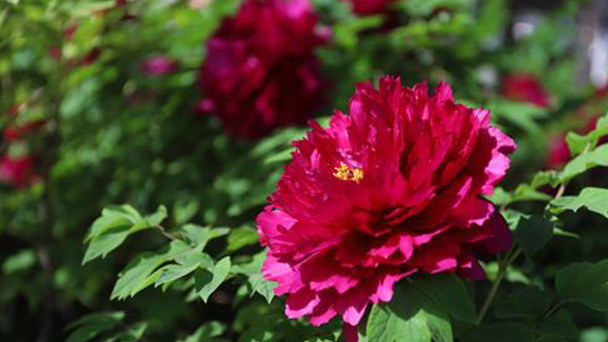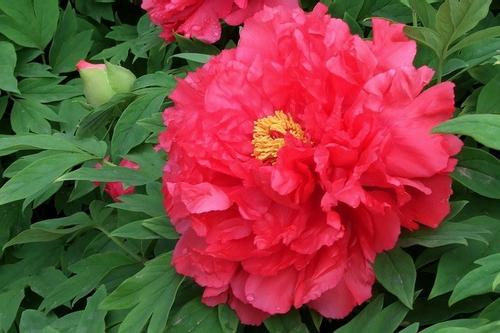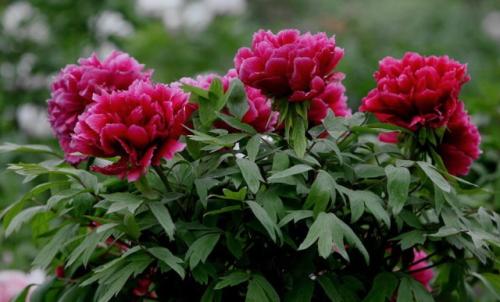Paeonia Suffruticosa (Tree Peony) Profile
Written by Maggie
Nov 03 2021

Paeonia Suffruticosa (Tree Peony) is a variety of peony, deciduous shrub. Paeonia Suffruticosa is tall, erect. Branches are thinner and stiffer. Leaves are broadly ovate, surface green, glabrous, abaxially pale green, sometimes pinkish, sparsely pubescent or sub glabrous along veins. Flowers are solitary branch apex, bracts 5, long elliptic, unequal in size.
Paeonia Suffruticosa Picture

Paeonia Suffruticosa Info
| Botanical Name | Paeonia suffruticosa |
| Common Names | Tree Penoy |
| Plant Type | Deciduous shrub |
| Sun | Full sun to part shade |
| Hardiness Zones | 4 to 8 |
| Flower color | White, red, pink, purple, yellow |
| Native Area | China, Bhutan |
| Mature size | 3 to 5 feet tall and 3 to 4 feet wide |
Paeonia Suffruticosa Characteristics
Paeonia Suffruticosa Leaf
Paeonia Suffruticosa is a deciduous shrub. Plants are tall, erect. Branches are thin and stiff, 1-year branches long, internodes also long; Scales and buds are rounded and pointed. Medium long leaves, stiff; Broad is ovate, 7 -- 8 cm long, 5.5 -- 7 cm wide, surface green, glabrous, abaxially pale green, sometimes pinkish, sparsely pubescent or sub glabrous along veins, total petiole ca. 12 cm long, oblique; Lateral leaflets are ovate, many notches, end acuminate, leaf surface green.
Paeonia Suffruticosa Flowers
The flowers of Paeonia Suffruticosa are rose-shaped. Buds are rounded and pointed. The flowers are purplish red and shiny; The flower diameter is 17 cm x 9 cm. Petals are hard and neatly arranged, with purple spots at the base; Some stamens often petals. Pistil many and small, room clothes dark purple red, occasionally strong. Pedicels are long and stiff, flowers erect.
Paeonia Suffruticosa Habits
Paeonia Suffruticosa has strong growth potential, high flowering rate and much sprout tillering. Paeonia Suffruticosa likes warm, cool, dry, sunny environment. paeonia suffruticosa is pleasant to sunshine, also resistant to half shade, cold, drought resistance, resistance to weak alkali, avoid water, afraid of heat, afraid of direct sunlight.It is suitable for growing in loose, deep, fertile, high-drought-terrain and well-drained neutral sandy loam. Poor growth in acidic or clayey heavy soils with a pH value of 6.5-7. Adequate sunlight is beneficial to the growth of the plant, but it can not tolerate the hot sun in summer, and the temperature above 25℃ will make the plant dormant. The suitable temperature for flowering is 17-20℃.
How to Care for Paeonia Suffruticosa
In the Paeonia Suffruticosa growing season, there should be timely tillage, pull out weeds, pay attention to disease, insect occurrence. In autumn and winter, the days where Paeonia Suffruticosas grow more than two years are ploughed. After three or four years of Paeonia Suffruticosa growth in the pot, it is necessary to change into a big pot with new soil or plant in the autumn. Spraying sulfur mixture before early spring germination, summer with insecticide, fungicide mixture, depending on the condition every 2 weeks. Combined with fertilization, it is advisable to add chemical fertilizer and growth blending agents. To increase festival or celebration activities, Paeonia Suffruticosa can be heated up about 50 days in advance according to the variety. The temperature is controlled to be 10-25℃ at normal temperature, and the average daily temperature is about 15℃. Pay attention to keep the Paeonia Suffruticosa moist in the early stage, pay attention to ventilation and light after bud forming, and control the temperature according to the requirements of flowering period. Want to line foliar fertilization at ordinary times, ensure adequate water supply. In this way, winter and spring flowers can be seen at any time.
Planting Paeonia Suffruticosa
The soil for Paeonia Suffruticosa should be loose, fertile and moderately alkaline. The broken and diseased roots of the Paeonia Suffruticosa seedlings are cut off, and the insecticides and fungicides are put into the pots or pits prepared in advance. The roots should be extended, and the soil should be filled to most parts of the pots or pits to lift the seedlings gently and shake, and the soil should be sealed firmly. The roots and stems should be slightly lower than the surface of the basin or the ground.
Paeonia Suffruticosa Watering
Pour a flood after planting. Paeonia Suffruticosa bogey water, the growing season as appropriate watering.In northern arid areas, water before watering flowers, water after flowering and frozen water are common. For the convenience of management, the flower can be cut off after blooming and buried in the pot.
Paeonia Suffruticosa Fertilizer
After planting Paeonia Suffruticosa for a year, autumn fertilization is feasible, mainly decomposed organic fertilizer. It can be combined with loose soil, scattered and acupoint application. Spring, summer multi-purpose chemical fertilizer, combined with watering fertilizer before applying flower fertilizer after flower. Pot load can be combined with water application of liquid fertilizer.
Paeonia Suffruticosa Light Requirements
Grow tree peonies in full solar to dappled shade. The plant life can also go through in warm summer time sun; presenting some coloration helps.
Paeonia Suffruticosa Soil Care
These vegetation like to develop in a floor that is well-drained, with a soil pH that is impartial or barely alkaline. Paeonia Suffruticosa will thrive in a loamy soil fortified with compost.
Paeonia Suffruticosa Temperature & Humidity Care
Paeonia suffruticosa have chilling requirements, so they develop fantastic in areas that ride bloodless temperatures at some stage in the winter. In addition south you go in their range, the greater experience it may additionally make to develop them in dappled shade. For fall care, mulch to furnish extra iciness safety if you stay in a location where the flowers are solely borderline-hardy.
Pruning Paeonia Suffruticosa
Pruning is not often indispensable on Paeonia Suffruticosa. They are now not like herbaceous peonies, which reduce or die lower back to the floor every year. However, you must prune the shrub to do away with lifeless branches. If there are branches that end result from suckering from the herbaceous rootstock, get rid of these too. When you prune, wait until early spring to function the operation; keep away from pruning in fall, as aboveground increase helps safe haven the root gadget in winter.
Paeonia Suffruticosa Early Spring Care
Topdress flowers with an inch of compost or aged manure. Watch for symptoms of fungal ailment and deal with as needed. If a shot arises from the rootstock, put it off.
Paeonia Suffruticosa Mid-Spring Care
Some sorts may additionally want help for the heavy flowers. If the indoors of the plant is crowded with foliage, skinny it out to enhance air circulation.
Paeonia Suffruticosa Late Spring Care
Do no longer overwater. Be diligent with deadheading spent blossoms and do away with historic plant life and petals from the garden.
Paeonia Suffruticosa Summer Care
Only water vegetation when soil dries out to a depth of 4 inches, and then water deeply. Foliar feeding with fish emulsion is appreciated.
Paeonia Suffruticosa Fall Care
Do no longer prune Paeonia Suffruticosa back; they are woody shrubs. Remove all foliage after frost, however do no longer compost. Mulch new flora and these grown in the chillier zones, and if bloodless iciness winds are expected, wrap flora with burlap or different defensive material.
Read More: How to Grow and Care for Paeonia Suffruticosa.

Varieties of Paeonia Suffruticosa
P. suffruticosa 'Red': Bears a outstanding crimson flower (not red); blooms fairly early in spring
P. suffruticosa 'Kinkaku': Bicolored vegetation of light yellow with purple edges; blooms a few weeks later than P. suffruticosa 'Red'
P. suffruticosa 'Kinshi': Also known as the "Golden Bird," due to the fact it bears large flora in a golden-yellow color
P. suffruticosa 'Qing Xiang Bai': Produces single blooms (most Paeonia Suffruticosas have double blooms)
Paeonia Suffruticosa Propagation
Paeonia Suffruticosa Division Propagation
The specific method of Paeonia suffruticosa division propagation is: dig up the whole Paeonia Suffruticosa which grows luxuriant, and separate it from the junction of root texture. The number of molecular plants in each plant is determined by the original plant size, and the large ones are more than the small ones. Generally every 3-4 branches for a child plant, and have a more complete root system. Then with a little sulfur powder and mud. Daub and wipe the wounds on the roots before planting Paeonia Suffruticosa again. The time of seedling propagation is in the annual autumnal equinox to the frost's fall period, it is better to carry out timely. At this time, the air temperature and ground temperature are high, and the Paeonia Suffruticosa is in a semi-dormant state, but there is still a long period of vegetative growth time. The effect on root growth is not very serious by dividing the plant, and some new roots and a small number of plant buds can be produced after dividing the Paeonia Suffruticosa. If the sub-plant planting is too late, the root growth in the year is very weak, or no new roots, the next spring, plant development is weaker, weak roots are not drought resistant, easy to die.If the plant is premature, the temperature and ground temperature are higher, but also rapid growth, easy to cause autumn hair.
The mother plant of the ramet of the Paeonia Suffruticosa, usually using a robust cluster. The roots and tillers of the mother plants should be kept as far as possible, and all the roots of the new seedlings should be kept, so that the new seedlings can be multiplied after 5 years of growth. Such plant seedlings are easy to survive after planting, and the growth is also more vigorous. The more roots you retain, the more you grow.
Paeonia Suffruticosa Cutting propagation
Cuttage propagation is a method to propagate new Paeonia suffruticosa plants by making use of adventitious roots easily from peony branches. It is one of the methods of asexual propagation. The method is to cut the cuttage branches first, from the mother plant, and then inserted into the soil or other matrix so that the root becomes a new plant. The branches that Paeonia Suffruticosa cottage reproduces, should choose to send out by peony root in those days native soil bud branch, or when Paeonia Suffruticosa pruning, the choice stem is substantial, terminal bud is full and the branches that have no disease and insect pests make ear, grow 10-18 cm. The root of Paeonia Suffruticosa is a fleshy root, like high and dry, to avoid moisture, drought tolerance. Therefore, the nursery bed should choose a ventilated sunny place, build into a high bed nursery seedling. Cutting, insert a row irrigation a row, thoroughly.

Latest Updated
- Benefits of Bugleweed - 7 Science-backed Health Benefits
- Bugleweed Dangers & Side Effects - Is It Poisonous?
- How to Plant Evergreen Trees - What You Should Know
- When to Plant Evergreens - Grow Guide for Evergreen Trees
- 12 Wonderful Evergreen Shrubs for Your Garden
- 12 Popular Evergreen Plants with Pictures for Beginners
- When And How To Prune A Lilac Bush Like a Pro
- How to Grow & Care for Lilac Vine (Hardenbergia Violacea)
- Japanese Lilac Tree (Syringa Reticulata) Care & Propagation Guide
- Shumard Oak Pros and Cons - What to Know
Popular Articles
- Winter maintenance of Antirrhinum Majus
- How to Grow Terminalia Mantaly Tree
- How to Grow and Care for Crossostephium Chinense
- How to grow Antirrhinum Majus in spring
- Peristeria Elata (Dove Orchid) Profile: Info & Care Guide
- Underwatered Snake Plant (Sansevieria Trifasciata) - Signs And How To Fix
- How to Care for Brazilian Jasmine Plant (Mandevilla Sanderi)
- How to Grow & Care for Graptopetalum Purple Delight in Summer
- Rosa Chinensis (China Rose): Plant Growing & Care Tips
- How to Care for Baby Sun Rose (Aptenia Cordifolia)